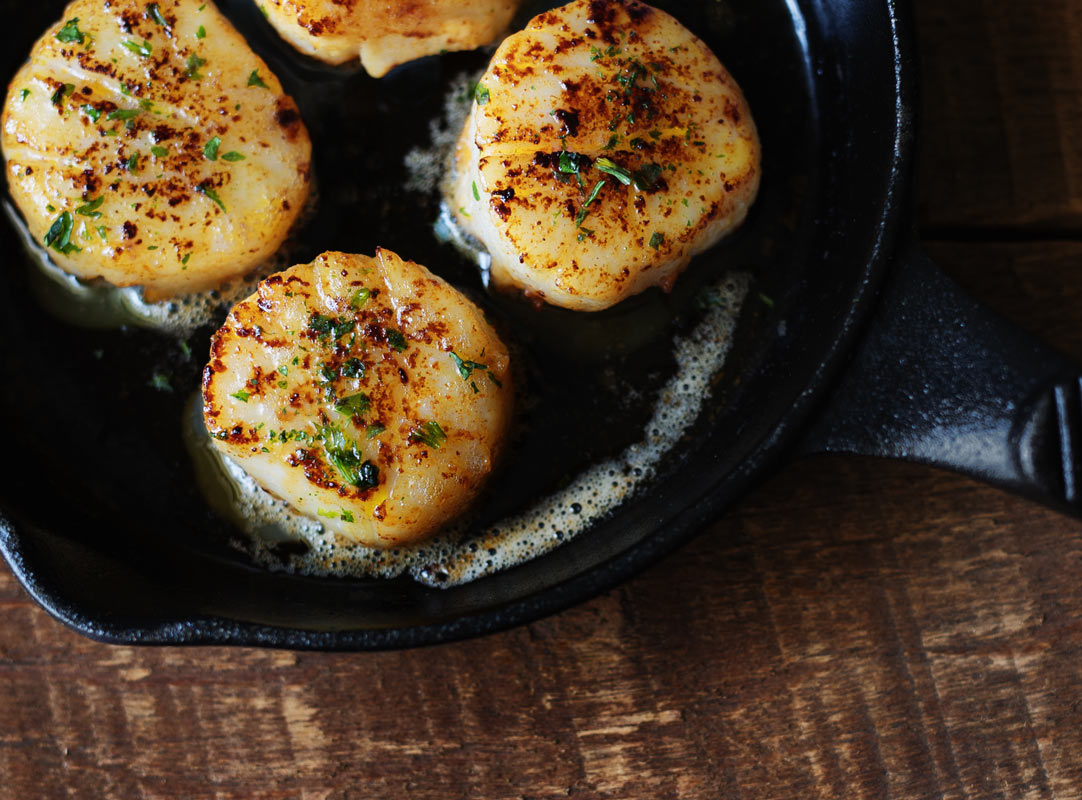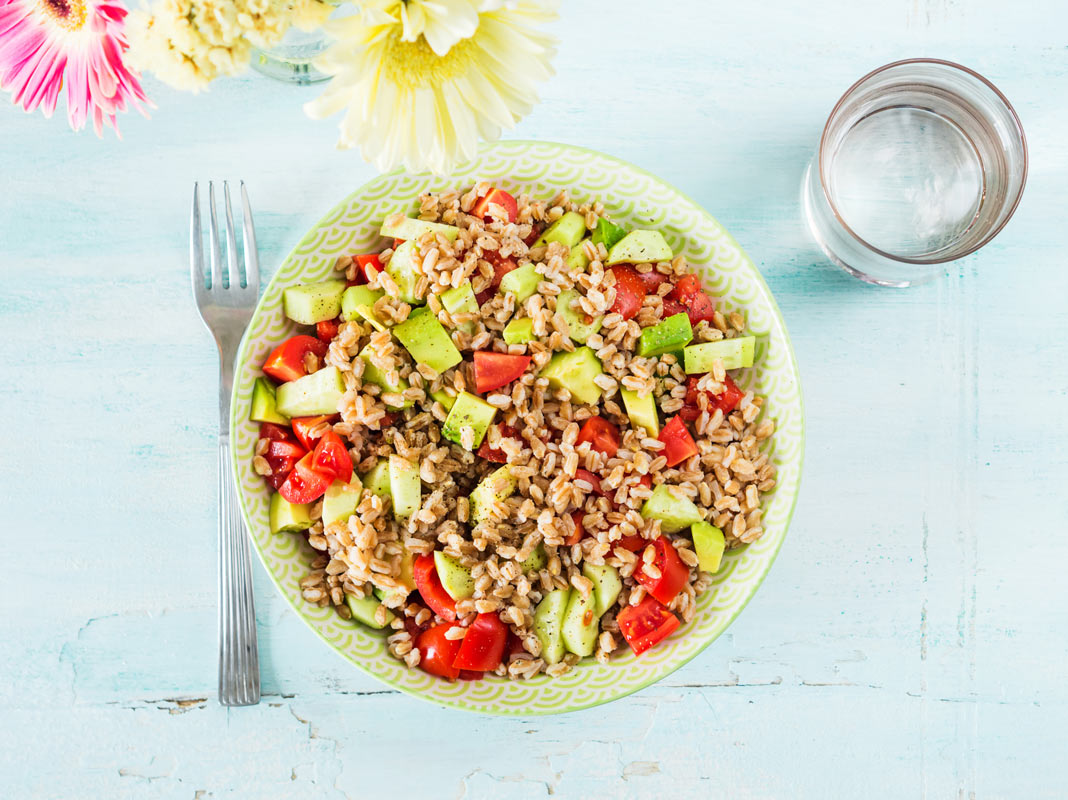Seared Scallops with Farro Recipe, Spotlight on Farro and Scallops, A Fresh Look at Health and Fitness Apps, Plus 15 Minutes to Change Your Health
Craving shellfish, but hesitant to make it at home? Scallops are a great seafood choice and simple to prepare—a quick sear is all it takes for these sweet bites. My recipe pairs them with farro, a fantastic ancient grain. Both are high in nutrients and fit perfectly in a health-conscious diet. If you’re looking for more ways to boost health, two studies from researchers at the University of South Australia are full of easy-to-implement ideas to help people reach their goals.
Seared Scallops with Farro
 Seared Scallops with Farro
Seared Scallops with FarroThis dish comes together in short order yet makes for an elegant presentation. The technique also lends itself to shrimp (if you make that swap, use one pound of peeled shrimp).
Ingredients
- 1 tablespoon onion powder
- 1 tablespoon garlic powder
- 2 teaspoons sweet paprika
- 1/2 teaspoon fine sea salt
- 1/2 teaspoon freshly ground black pepper
- 1 pound dry sea scallops
- 3 tablespoons extra virgin olive oil
- 2 garlic cloves, minced
- 1/2 cup white wine or clam juice
- 2 tablespoons butter
- 2 cups cooked farro
- 2 tablespoons chopped fresh flat-leaf parsley
Directions
Step 1
Mix the onion powder, garlic powder, paprika, salt, and pepper in a pie plate. Heat a large skillet. While the pan is heating, pat the scallops with a paper towel and dredge in the spice mixture. When the pan is ready, add the olive oil and the scallops. Sear the scallops until browned and crispy on the edges, about two minutes on each side, then transfer them to a dish.
Step 2
Add the minced garlic to the pan and sauté until soft, about 3 minutes. Deglaze the pan with the wine or clam juice and add the butter, swirling it until it melts into the pan juices. Add the cooked farro and toss to coat. Sprinkle with the parsley. Mound equal amounts of the farro on 4 plates and add equal amounts of scallops.
Yields 4 servings

Healthy Ingredient Spotlight
Get Familiar with Farro

Ancient grains are having a resurgence thanks to growing interest in eating foods that haven’t been refined or altered genetically to make mass production easy. Farro is one of these tasty whole grains though it might not be as well-known as barley and quinoa…yet!
Grown for centuries in the swath of land in the Middle East known as the Fertile Crescent, farro’s popularity first spread across Europe, notably Italy. Its nutty flavor and toothsome texture make it extremely versatile—it’s delicious as a hot side dish, a cold salad, an enrichment to soups and stews, and a breakfast bowl with yogurt and fruit.
Rich in protein, farro is also a great source of fiber if you choose whole, which is intact, or semi-pearled, which has some of the bran removed. As with dried beans, whole farro benefits from an overnight soak in water before cooking on the stove—put 1 cup in a bowl, cover with water, and pop in the fridge. To cook, drain the farro and add to a pot along with 3 cups of water, bring to a boil and simmer for 10 to 15 minutes; the texture should be similar to pasta cooked al dente, slightly firm and chewy, not mushy or gummy.
To extend shelf life, store farro with other whole grains and nuts in the fridge or freezer.

Quick Kitchen Nugget
Selecting Scallops
With their sweet taste and firm texture, scallops are a succulent seafood that sautés quickly. You can enjoy them in a traditional garlic and parsley sauce or a tomato-based preparation, or season them with exotic spices. They can be costly but there’s no waste and they’re a great source of protein and other nutrients, including some of the B vitamins and the minerals selenium, zinc, iron, and phosphorus.
Since scallops aren’t typically sold in the shell, like oysters, clams, and other shellfish, you don’t run the risk of getting an “old maid,” or a piece that doesn’t open. But there’s more to choosing scallops than meets the eye. Specifically, you want to always ask for “dry scallops,” which are natural, and avoid “wet” scallops. As the experts at New York’s famed Fulton Fish Market, which ships scallops nationwide, explain, “wet scallops are treated with water and a chemical solution (sodium tripolyphosphate, or STPP) to preserve [them] and keep them white. They have a faint chemical taste and are near-impossible to sear because of the high water content. They release water when cooked, causing them to steam instead of sear.” Always ask if the scallops aren’t marked as being dry.
Unlike other farmed seafood, line-farmed scallops, often produced by small-scale farmers in Maine, are a sustainable alternative to wild-caught. They feed naturally in the ocean as do other farmed bivalves, like mussels and oysters.
The big question is often whether to buy sea scallops—the large round ones—or small, nugget-like bay scallops. The answer often depends on taste and timing. Sea scallops are usually available year-round, while bay scallops, notably the famed ones from the Northeast’s Nantucket Bay and Peconic Bay, are available in season, which runs from November through March.

For Your Best Health
A Fresh Look at Health and Fitness Apps
Calorie counters and step trackers have sometimes gotten mixed reviews when it comes to their usefulness as diet and exercise aids. But a new analysis by researchers at the University of South Australia (UniSA) in Adelaide that looked at data from 206,873 people across 47 studies found that digital health tools, like mobile apps, websites, and text messages, can indeed pack a real punch when it comes to getting results.
Specifically, electronic and mobile health interventions can help people achieve:
- 1,329 more steps per day
- 55 minutes more moderate-to-vigorous exercise per week
- 45 minutes more overall physical activity per week
- 7 hours less sedentary behavior per week
- 103 fewer calories consumed per day
- 20 percent more fruits and vegetables consumed per day
- 5.5 grams less saturated fat consumed per day
- 1.9 kilograms of weight loss over 12 weeks
- Improved sleep quality
- Less severe insomnia
“With the rise of preventable chronic diseases like obesity, cardiovascular disease, and type 2 diabetes, finding mechanisms that can help reduce people’s risk is important,” said UniSA’s Dr. Ben Singh, the paper’s lead researcher. “Our study found that digital and mobile health interventions can have a positive effect on people’s health and well-being, not only helping them to increase their physical activity and reduce sedentary behavior, but also improving their diet and quality of sleep.
“Given the wide accessibility and popularity of health apps, their capability to tailor information and deliver timely reminders and prompts, and scalability to diverse populations, they could be a very effective intervention to promote better health. Making positive changes to your health and well-being can be a challenge—it’s always easier to add kilos to your waistline than it is to reduce them—but by incorporating digital tools into your everyday life, you’re more likely to achieve positive outcomes.”
The research identified consistent findings across different age groups, health behaviors, interventions, and health populations, indicating that digital health apps could help underpin broader public health campaigns. While the researchers recommend more study to better understand the impacts among specific groups of people, at the top line, digital health apps appear to be a win-win for all. Their study were published in the open-access journal npj Digital Medicine.

Fitness Flash
Got 15 Minutes to Change Your Health?
In a separate study led by UniSA’s Dr. Singh, researchers found that it takes just 15 minutes and a touch of gamification to put people involved in company wellness programs on the path to success. Assessing results from 11,575 participants across 73 Australian, New Zealand, and UK companies, UniSA researchers found that a gamified six-week workplace wellness program called the 15 Minute Challenge led to substantial increases in physical activity levels, with 95 percent of participants meeting (36 percent) or exceeding (59 percent) physical activity guidelines.
In addition, participants’ average daily physical activity levels increased by 12 minutes per day (85 minutes per week) throughout the six-week challenge, with a median daily exercise duration of 45 minutes. Participants also reported improvements in fitness (14 percent), energy (12 percent), overall health (8 percent), sleep quality (8 percent), and mood (7.1 percent).
The WHO recommends that adults ages 18 to 64 do at least 150 to 300 minutes of moderate-intensity aerobic physical activity or at least 75 to 150 minutes of vigorous-intensity aerobic physical activity over a week.
“Regular physical activity provides significant physical and mental health benefits,” said Dr. Singh. “It plays a key role in preventing and managing chronic disease, such as cardiovascular disease, type 2 diabetes, and cancer, and it also reduces symptoms of depression and anxiety. Yet around half of Australian adults do not meet the recommended levels of physical activity. With the majority of adults spending much of their waking time working, workplaces present ideal settings for promoting physical activity. The 15 Minute Challenge presents an effective mechanism to help boost employee health and well-being in the workplace.

“In this study we showed that as little as 15 minutes of physical activity per day can make a big difference when it comes to people’s health and well-being. And while the program only required 15 minutes of daily activity, most people tended to do more. The 15-minute goal essentially serves as an accessible starting point, especially for people who are particularly sedentary. So, it reduces barriers to entry and helps build the habit of regular exercise. Ultimately, the 15 minutes is a catalyst for increased physical activity, with many participants ending up exceeding the minimum goal and moving closer to or surpassing national recommendations.”
UniSA professor Carol Maher, PhD, a co-researcher on the study, said that part of the program’s success is in the gamification and the social aspects of the app. “Encouraging and keeping your teammates accountable through friendly competition is central to the 15 Minute Challenge app, and a key part of what motivates participants to stay committed and connected,” Dr. Maher said. “The program encourages team collaboration to track rankings and display cumulative exercise. Achievements are clearly noted, and successes are celebrated. So, it’s certainly a tool that engages people to work together and have fun.
“What we need to remember, however, is that addressing inactivity is everyone’s responsibility. So, if an employer can initiate an effective, enjoyable, and cost-effective option to support their employees, it’s a win-win. Physically active employees are happier and healthier; they are more productive, more satisfied, less stressed, and less likely to get sick. Sustainable, scalable initiatives like the 15 Minute Challenge that can support employees to change their health and well-being for the better should be on every employer’s agenda.”
Get More Recipes In Your Inbox!